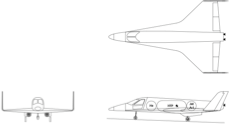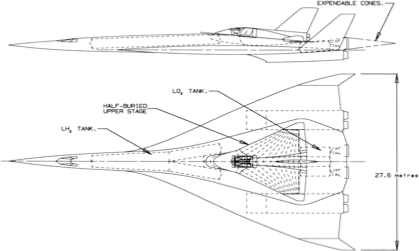The Great Space Scandal
The development of commercial spaceplanes has been delayed for 30 years. But that's about to change.
by David Ashford
Abstract
The Great Space Scandal
The development of commercial spaceplanes has been delayed for 30 years. But that's about to change.
by David Ashford
Abstract
| ||||||||||||||||||||||||||||||||||||||||||||||||||||||||||||||||||||||||||||||||||||
|
A transformation of spaceflight is imminent. It involves replacing expendable launchers like ballistic missiles with reusable ones like aeroplanes (spaceplanes). Within ten to fifteen years, the cost of space science will probably be approaching that in Antarctica and public access to space will be affordable and routine. The scandal is that this could have happened some thirty years ago if the spaceplane projects of the 1960s had been adopted. Even now, government space agencies and major contractors are showing little interest in spaceplanes.
Introduction
In 1961, I was hired straight from university to work with the Hawker Siddeley Aviation Advanced Projects Group at Kingston. My first job was in the hypersonics team. Among the projects we investigated were spaceplanes—aeroplane-like vehicles capable of flying to and from orbit to launch a satellite or supply a space station. The big idea was to replace the converted ballistic missiles then in use with vehicles that could fly more than once. In principle, this involved adding wings, tail, cockpit, landing gear, and heat shield to an otherwise expendable vehicle. One does not need to be a rocket scientist to appreciate that an aeroplane is a much more practical and economical form of transport than a ballistic missile. Most large European and US aircraft companies had similar ideas. By the mid-1960s there was a consensus that spaceplanes were the obvious next step in space transportation and were just about feasible with the technology of the time. The X-15 rocket-powered research aeroplane was making regular flights to space, albeit on a sub-orbital trajectory that gave but a few minutes above the atmosphere. Several papers at the time, including one by myself, predicted that spaceplanes would lead to an airliner service to and from orbit, reducing the cost of transport by several orders of magnitude. This would lead to a new space age, although that expression was not used at the time. Well, it has never happened. To this day, all spacecraft have been launched by vehicles with large complex throwaway components. How has this come about? To answer this question, we need to look at history. The first satellites were launched using converted ballistic missiles rather than rocket-powered aeroplanes because the latter would have taken longer and cost more to develop. Due to pressures of the Cold War, the first men in space also got there on top of ballistic missiles and the use of expendable launchers persisted during the 1960s race to the moon. The next major project was the Space Shuttle, the design of which started In the 1970s. The advantages of spaceplanes were by then widely appreciated and the early designs of the Space Shuttle were indeed fully reusable. Budget pressures then forced NASA This history has created ways of thinking and institutions repeatedly reinforcing the throwaway launcher habit. This mind-set is the largest obstacle in the way of spaceplane development. Even today, NASA However, all is not lost. The private sector has taken the lead. The first privately funded spaceplane, SpaceShipOne Present designs are sub-orbital in that they can fly fast enough to zoom up to space height for a few minutes but not fast enough to stay in orbit. Orbital spaceplanes need some six times the speed of sub-orbital ones and will cost some ten times more to develop. This cost is at present beyond the means of the private sector. The best way ahead is probably a public-private partnership. Government would pay for developing prototypes adequate for their own purposes. The private sector would then take over commercial exploitation. Governments would save money on present space programmes alone. Their reluctance to become involved in such a programme is little short of scandalous. Perhaps surprisingly, the UK is best placed to break the mould of thinking on space transportation. We have all the technology for an entry-level spaceplane; we have a world-class aircraft industry; and we are the only major industrial country without significant interests vested in ‘old space’. If we start down the winning strategy, we should be able to persuade international partners to join in a programme of further development. In this way, the UK could become the centre for a large new European spaceplane industry. The rest of this paper considers two key aspects of this situation in more detail. First, we will consider the potential of spaceplanes to reduce launch cost. Then we will show how the UK could take the lead.
Rockets, Aeroplanes, and Spaceplanes
It is relevant to consider precisely why present-day spaceflight is so expensive. Fig. 1 compares expendable launchers with airliners. The cost per seat to orbit in a launcher is about four orders of magnitude higher than a seat in a long-distance airliner flight. The main technical difference is that an airliner can be flown tens of thousands of times whereas a launcher can be flown once only. The other technical differences have some effect on cost but none are nearly as significant. The main operational difference is that airliners make some ten million flights per year in total whereas launchers make fewer than 100. This follows from their high cost. Expendable launchers are so expensive that they are suitable only for government missions and for the few commercial applications that can afford such high costs, especially satellites for communication. There are about twenty launcher types on the market, so the average number of flights per year each is less than five. Not very efficient!
Figure 1. Launchers Compared with Airliners
Present-day airliners of course cannot fly to and from orbit. So how will spaceplanes compare in cost with airliners? Fig. 2 shows some estimates for a spaceplane with a take-off weight comparable to that of a large airliner. We have assumed a technology level such that prototypes could be built in five to seven years and that the design has then matured following a long production run with continuous product improvement.
Figure 2. Spaceplanes Compared with Airliners
When fully developed, there is no obvious reason for spaceplanes to have a much shorter life than airliners. They will cost several times more per flight because of greater complexity and because they will probably use hydrogen fuel, which is expensive. They will carry fewer seats because they have to carry more fuel. The resulting cost per seat will be very roughly twenty times mores than a seat in a long-distance airliner flight, at around ten thousand dollars. This is some 1000 times lower than the cost today. When these low costs are achieved, the cost of space science will become comparable with that in Antarctica. Public access to orbit for business or leisure will become routine and affordable. There are millions of people in the industrialised world who would be prepared to save for the trip of a lifetime to a space hotel for a few days. In effect, we will have a new space age. It must be emphasised that costs that low depend on fully mature spaceplane designs. Early prototypes will cost far more. These could be built in five to seven years, and it would then take about eight years to mature the designs, especially to develop a long-life rocket engine. Thus, a 1000 times cost reduction appears to be possible within 15 years.
How the UK Can Lead
The main obstacle to achieving the new space age soon is mind-set. Even now, NASA  When it was cancelled in 1958, Saunders Roe proposed a space research variant. The Ministry showed some interest, but not enough to make it happen. What might have been! My own company’s entry-level spaceplane project, Ascender  Ascender  Spacecab
Conclusions
A new space age is in sight, with greatly reduced cost and improved safety. The main obstacle is the scandalous failure over the past few decades of government space agencies to take this prospect seriously. However, courtesy of private sector initiatives, progress at last appears to be possible.
David Ashford
Read more from David Ashford in the Archive | ||||||||||||||||||||||||||||||||||||||||||||||||||||||||||||||||||||||||||||||||||||
